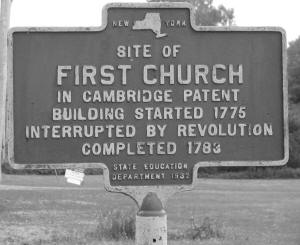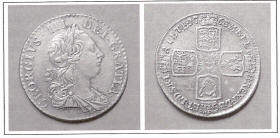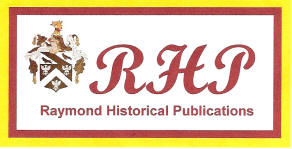|
|
|
Last time: After circling back to the Cambridge Patent of 1761, the keynote event commemorated in Cambridge this year, we joined the opening salvoes of the Revolution (1763-76) and the role the area played in that chapter of America’s story.
Chapter 12: The Revolution, Thrusts and Parries - 1777-1779 In early 1777 New York City was locked down by the English Army and Royal Navy. The newly declared Independents were operating out of Philadelphia while trying to manage the flow of information vital to the Revolutionary cause between Boston and Savannah and points in between. With the Occupy Wall Street crowd clad in coats of red, a rebellious New York government repaired up the Hudson to Kingston, and after many months of wrangling and rewrites, the very first New York State Constitution was approved on 20 April 1777 to read as follows: CONVENTION OF THE REPRESENTATIVES OF THIS STATE OF NEW YORK “Whereas the many tyrannical and oppressive usurpations of the King and Parliament of Great Britain on the rights and liberties of the people of the American colonies had reduced them to the necessity of introducing a government by congresses and committees, as temporary expedients, and to exist no longer than the grievances of the people should remain without redress; And whereas the congress of the colony of New York did, on the thirty-first day of May now last past, resolve as follows, viz…” A bunch of additional whereases and resolveds followed. Under this new legal instrument, the Assembly provided for 70 members allotted as follows: to the city and county of New York (Manhattan); city and county of Albany; counties of Dutchess, Westchester, Ulster, Suffolk, Queens (and Nassau), Orange (and Rockland), Kings (Brooklyn), Richmond (Staten Island), Tryon (Montgomery), and even Cumberland and Gloucester (later partitioned to create Vermont.) Nothing mentioned of the scattered outposts of the Adirondacks and Finger Lakes. Charlotte County (our own Washington since 1791) was given four delegates by the new law. Word filtered into the Owlkill but the residents suspected that wouldn’t be the end of it. So with the late spring thaw of ’77—ice didn’t go off Big Pond (Hedges) until mid-late May as this was near the end of the Little Ice Age—work was suspended on the first church building in the Cambridge District, on the Turnpike south of the village (see the photo), due to the spreading strife with the Crown.
Good news of the
revolt ebbed and flowed with the bad throughout the summer of 1777.
To the north at Fort Ticonderoga dozens of cannon were captured from
the inattentive Brits by the Green Mountain Boys and hauled to
Bennington to add to the cache of arms there.
The King’s men turned south and marched down the Turnpike a few more miles, but in the fields and atop a knoll near Wallomsac, militia, led by New Hampshire Gen. John Stark and Vermont Col. Seth Warner, were joined by sod-busters and dairymen, millers and smiths to halt their advance. Names appearing on the 1761 Cambridge Patent who no doubt took up arms included a Baker, a Barber, and a Beach; two Coulters and four Cowans. Also James Cowden, proprietor of the tavern just south of Cambridge on the Turnpike, which was requisitioned by the intruders as a temporary base of operations, then later likely a hospital by the Colonials. A Perry, a Peters, and a Pettit joined the original settlers Edmond and Joseph Wells, along with three Wrights and a Younglove, with many hundreds more at their sides. In fact, Caleb Wright is said to have molded musket balls from the lead weights of his “grandfather” clock; time stood still, if you will, and dropped its smartly uniformed targets in their tracks. Farmer George Gilmore was there that rainy, hot and sticky afternoon to disable a key bridge and cripple the progress of the Hessians of Lt. Col. Friedrich Baum and Lt. Col. Heinrich von Breymann, along with the Rangers of British Capt. Fraser, leading a company of 50 select Redcoats, some out of the 29th Worchestershire Regiment of Foot. The enemy lost 207 killed that day, and 700 captured, while our ancestors suffered only 40 KIA and 30 wounded. It’s argued that Gilmore’s actions on 16 August 1777 triggered events that stopped the English Army’s push down the Hudson River corridor. Without the added Bennington munitions they stumbled two months later at Bemis Heights, forcing Gen. John Burgoyne’s stunning surrender to the Patriots on October 17. The heroics in the pastures of Wallomsac kept the Revolution very much alive, a boost for the Continentals in the Northern Theater of operations. The victory convinced France the following year to enter the war as an ally of the U.S., offering military assistance, troops and munitions and, significantly, the French Navy. Down in the mid-Atlantic, though, in late summer of ’77, the British captured the American capital at Philadelphia, a huge setback for the cause. The two armies traded shots outside the city, the Redcoats dealing a blow in September at Brandywine Creek but the Patriots holding their own in December at Whitemarsh. Three weeks earlier on November 15th the Articles of Confederation—presented to the Continental Congress back on 12 July ’76 on the heels of the Declaration—had been approved by delegates from around the colonies, our first national constitution; oddly it wasn’t France or Spain or Holland, but Morocco of all countries, who first recognized the USA as sovereign. During the winter of 1777-78 the Continental Army was encamped in the bleak countryside outside Philly at Valley Forge. The harsh weather, meager sheltering, limited supplies and food, and smallpox made for high troop casualties despite the efforts of Washington’s medics. Using a pioneering immunization procedure, they smeared infections from dying soldiers to open wounds of the healthy and realized some success. Gen. Washington constantly badgered Congress for funds to carry on, having lost key officers to their home states who simply had to go home because they were broke. The central corps of the Army survived to see the spring, and by the summer of 1778 were whipped into fighting shape by Continental Europeans, experts in military drill and tactics. With Boston, New England, and upstate New York secure, in 1779 Fortress West Point was constructed on a highly defensible site 130 miles down the Hudson from Cambridge. This became Gen. Washington’s new headquarters. A 150-ton link-chain was installed across the broad tidal flow to the east bank to control potential hostile river traffic. The fort never fell to the Redcoats despite American General Benedict Arnold’s treasonous effort to deliver its plans to the British in NYC. Arnold was captured but later escaped and “turned his coat”, becoming a British officer. He lived his final years in England, but disdained even by the Brits who highly prized loyalty, even among adversaries. Also in 1779 the U.S. Navy proved its mettle on the high seas far from home as the USS Bonhomme Richard defeated the HMS Serapis when Captain J.P. Jones, his Sailors and Marines boarded the British war vessel in English waters and raised American colors. To help fund the War, in October of 1779 the NY State Legislature enacted a tax to raise $2.5M. The District of Cambridge Tax Roll of December 27, 1779 listed 346 citizens from Edward Aiken to Joseph Younglove. Each was assessed per the value of his Real Estate (fields and forests) as well as Personal Estate (goods and live stock), with individual tax requirements ranging from $4 to $250. The wealthiest per their total tax bill included John Blair at $225; and Philip Vaness and Phineas Whiteside, both with $250 in taxes owed. The Rev. Whiteside, of course, established his church in West Cambridge by 1790. The largest land holdings of the day were by Aiken at $264 in taxes; Jabez Mosier, $269; Vaness, $330; and Lewis Vanswoort, $262. Folks with lots of stuff that the tax collectors could lay their eyes on were Samuel Hodges, $300; John Pettit, $216; Aaron Van Corla, $300; Vaness, $261; and John Wood, $238. By New Year’s Day 1780 the tide of war seemed to be turning in favor of the new republic. As noted, it was a struggle to fund the effort, yet there was likely little graft and waste, as hungry as the Patriots were for liberty. (In fact, then as now that’s what separates America and the Anglosphere from much of the rest of the world, absolute intolerance of corruption.) They rejected, not only the classism of the Tory-Loyalists, but Big Government as they drafted their own state charters independent of one another and free of a strong central law (for the moment.) The Revolutionary flames were fanned by farmers, wagon wrights and cobblers, by big-business merchants, plantation owners, and mechanical engineers: honorable, industrious, build-your-own venture capitalists. Call them conservative, traditional, religious, with sound business plans. Call them liberal, radical free-thinkers with libraries of the Classics, their quills crafting more. Yet would not the Founders—transposed to some distant future edging toward fiscal bankruptcy—would they not rebel against a tax-and-spend ideology of social tinkerers, a foreign socialism that all but suffocates the entrepreneurial spirit? If only because the framers from Boston to Richmond and points beyond, like the farmers of the Owlkill, all believed that vision and inventiveness can’t be regulated; that philanthropy given freely is more humane than coerced giving at the point of a bayonet; that a bill to make you buy something you don’t want or need (whether East India tea or health insurance), isn’t true American independence by any stretch. Next time: Chapter 13, The Revolution, Endgame - 1780-1785 Sources: A History of the Cambridge Area (R. Raymond, T. Raymond 2010); Act of New York State Legislature, 23 October 1779; David Thornton; Kenneth Gottry, Jr.; Joel Ketonen; public domain. Note: The nation’s first legendary fighting ship was reborn in 1946 as an attack carrier, Bon Homme Richard, CVA-31, with service in Korea and Vietnam (the author served aboard in 1968-69); it was scrapped in 1992. A third namesake, Bonhomme Richard, LHD-6, launched in the late ‘90s as a Marine Amphibious Assault Ship, fights gallantly in Middle Eastern waters in the War on Terror. The author may be contacted at tmraymond4@gmail.com.
|
|
CAMBRIDGE HISTORY LIVES © 2011
|



